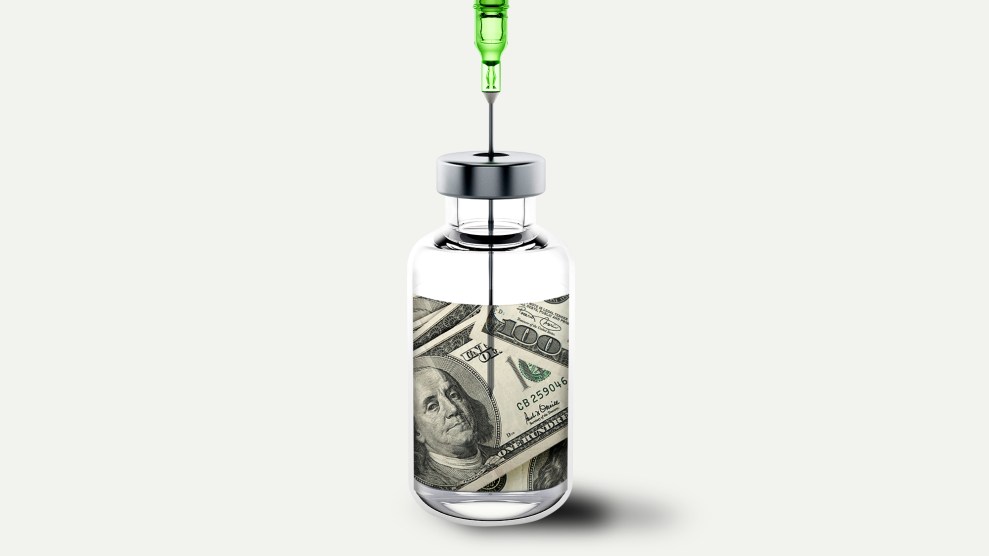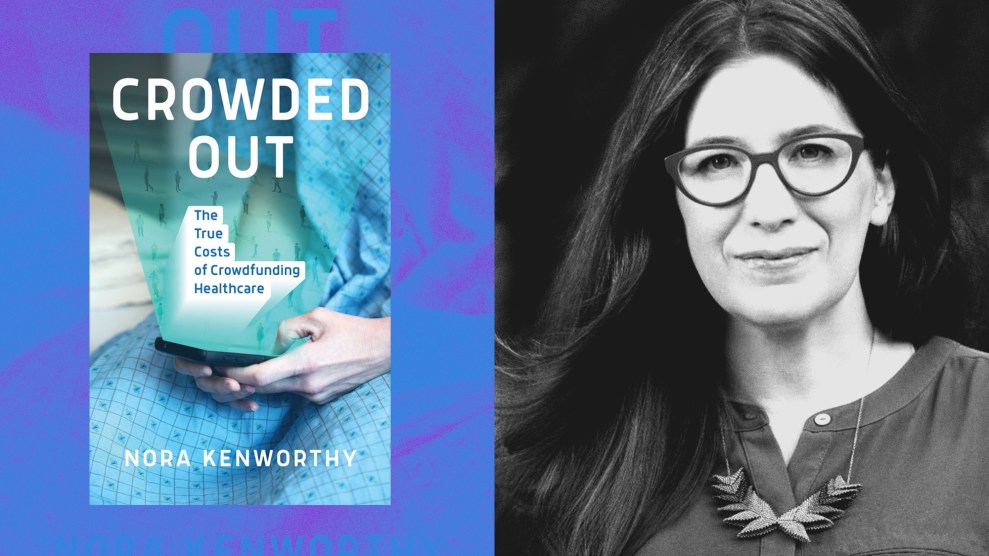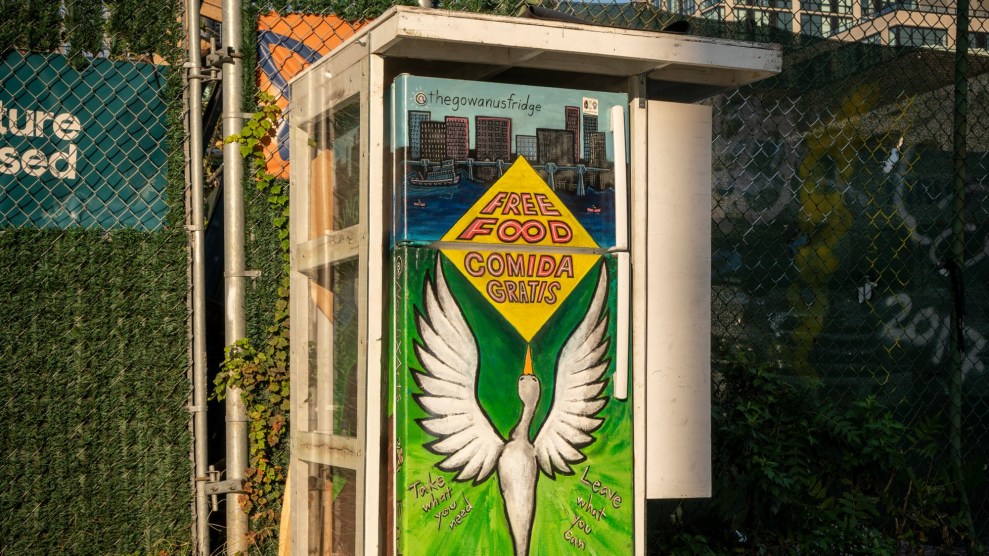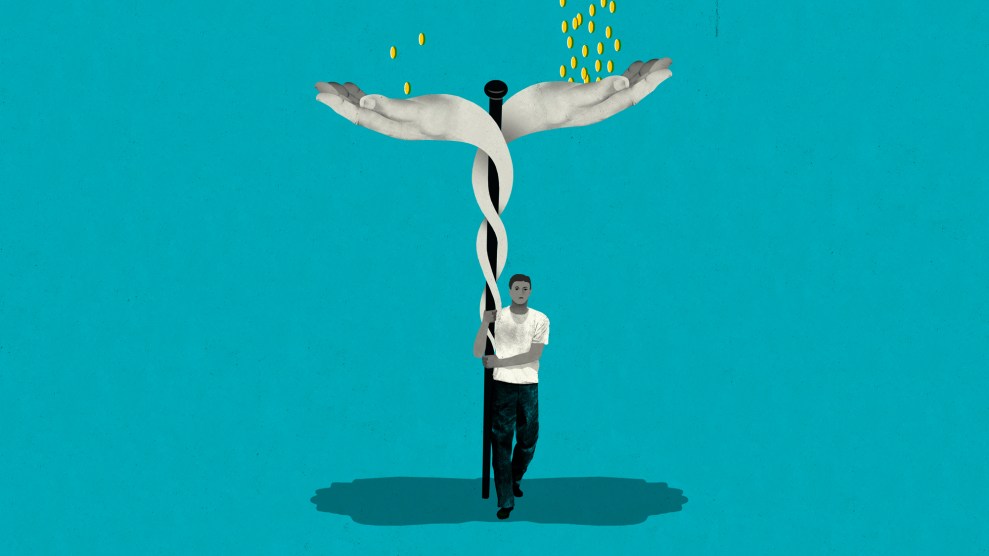
Mother Jones; Getty
Since May 2021, Rebecca Dotson has navigated type II diabetes with the help of mutual aid. Without the right resources—monitoring devices, insulin, and other medications—unmanaged diabetes can, at worst, kill people; it can also lead to expensive hospital stays and complications including amputations. Insulin is seven to 10 times more expensive in the United States than abroad, on average, which can be disastrous for uninsured and underinsured people.
A few months after she was first diagnosed, Dotson, a former registered nurse, reached out to a group called Mutual Aid Diabetes, which distributes funds and supplies like insulin pens around the US to those who need them—like Dotson, who now receives insulin and funds to help with insurance co-pays from the group as often as twice a month.
Dotson, who lives in Pennsylvania, has also been battling advanced bone cancer, which leaves her in a lot of pain. Knowing that she has a place to turn for help managing her diabetes takes some weight off her back, though not all.
“My diabetic medications are some of the most expensive and hard to get sometimes,” Dotson said.
An estimated one in six Americans on insulin have rationed it due to cost, which can lead to death.
Mutual Aid Diabetes, or MAD, is entirely volunteer-run. It came to fruition earlier in the Covid-19 pandemic through diabetics who wanted to help others in their communities—nearly 40 million Americans have a form of diabetes—survive to the next day when they couldn’t access insulin, or other diabetes medications and supplies. Unlike many patient-focused groups, they do not accept money from pharmaceutical companies.
An estimated one in six Americans on insulin have rationed it due to cost, which can lead to death. Rationing insulin, research shows, is more common among Black, middle-income, underinsured and uninsured people. Allie Marotta, one of MAD’s co-founders, knows what that’s like. At 26, Marotta, who lives in New York, was kicked off her parents’ health insurance plan. Marotta was an independent contractor working in theater, meaning she didn’t receive health insurance through her jobs.
“I was uninsured for a period of time, where I was rationing insulin,” Marotta said. “I was receiving black market donations for myself to use.”
Marotta then transitioned to helping others obtain the supplies they needed through such donations, often through direct messages on X/Twitter. Marotta and others wanted to make the process of asking for donations more accessible, which led them to create MAD.
An essential part of MAD’s work is community involvement from diabetics. The group has community partners, donors of insulin and other goods who MAD connects with diabetics in need who donate insulin and other goods and send it directly to a diabetic in need, as well as distributing funds directly to diabetics who need it as soon as possible. Its model—mostly diabetics helping others with diabetes—also aligns with the disability rights motto Nothing about us without us, involving people with the condition on both sides of the process.
Requests to MAD for both insulin and continuous glucose (blood sugar) monitoring devices, which cost from $100 to $300 per month, have increased. This past April, MAD received 52 aid form requests for help (where people could request multiple supplies at once), up from 7 in April 2021.
MAD wants its intake process to add as little stress as possible, Marotta says, as people are often in a crisis by the time they reach out. After a diabetic in need fills out a short form, a volunteer texts or emails to help get them medicine both directly and, if possible, through their insurance—though the wait is at least 48 hours, and it’s not a replacement for emergency care.
“We always recommend, go straight to the ER if you need direct medical care,” Marotta said.
It’s a common misconception that people with type II diabetes do not need or benefit from using insulin, despite the fact that type II diabetes often starts with insulin resistance. Fatphobia, anti-Blackness, and classism often contribute to that idea, according to MAD’s manifesto.
Fatphobia has also impacted the experience of getting care for people like Dotson, who put off seeing an endocrinologist for that reason: “I was afraid of just being told it was my fault because I was fat,” she said.
Some pharmaceutical companies do have programs for low-cost insulin, but many limit it to people with type I diabetes, leaving those with type II and other forms, including cystic fibrosis–related diabetes and latent autoimmune diabetes, in the dust.
Donating “was not only a cool mutual aid moment, but just a cool relationship-building interaction with a fellow diabetic moment.”
“Almost every manufacturer’s patient assistance program requires you to have type I diabetes,” Marotta said. “Sometimes they’ll phrase it as insulin-dependent diabetes, which does open a loophole for people with type II.”
It’s not just Big Pharma that makes problematic policy decisions around diabetes treatment. “Insurance companies have similar clauses where they won’t cover a continuous glucose monitor for someone”—which type II diabetics also need—”unless they have type I diabetes,” Marotta said. “To have to test your blood sugar instead of having a continuous glucose monitor is pretty archaic.”
The United States has moved to make insulin more affordable under the Inflation Reduction Act, capping its monthly cost at $35 for people enrolled in Medicare. However, some forms of insulin and other supplies—like injectable insulin, which isn’t used with a traditional insulin pump—are only covered by Medicare Part D, which patients have to pay more for.
Earlier this year, Dora Mendelson switched to a newer model of insulin pumps. When she saw a social media post from MAD about someone looking for the older ones she now had lying around, it was a no-brainer for Mendelson, who has since joined MAD as a volunteer, to redistribute her supplies.
“The person I actually sent the supplies to sent me a letter saying thank you, and that it was really a lifesaver,” Mendelson said. “It was not only a cool mutual aid moment, but just a cool relationship-building interaction with a fellow diabetic moment.”
Mendelson, who lives in Washington, D.C., felt drawn to mutual aid work because of hurdles she encountered seeking treatment as a graduate student in Canada, like longer wait times to see specialists and pressure to switch pumps.
Sully Carmona, who found out about MAD through a disability activist, saw the group highlighting the GoFundMes of diabetics in Gaza trying to leave the region in part to get insulin and other diabetes supplies, as well as raising awareness about the challenges these diabetics face on its social media. As the Guardian reported in February, though some aid trucks with insulin are getting into Gaza, Doctors Without Borders’ medical coordinator for the region says that “patients can’t get to the places where it is stocked because of the airstrikes.”
“As a person who has had the privilege of good health insurance throughout my life,” Carmona said, “I need to do all I can to support others who have been denied what they need for diabetes care, and to advocate for access for all.”












